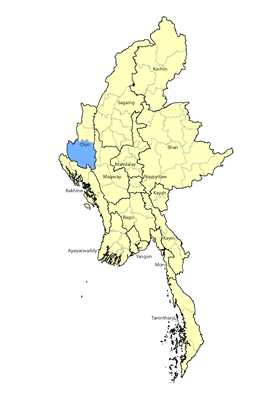The Bawm are believed to have originally been a clan or subgroup of the Zahau tribe, but today they are considered a separate people group. Their autonym is Bawm Hawlh, although in India, where the 4,400 Bawm people are acknowledged as a Scheduled Tribe, they are considered part of the larger Mizo group and are labelled “Mizo Bawm.”
In Myanmar Bawm people live in a tiny area about 31 miles (50 km) from the juncture of Myanmar, India, and Bangladesh. Their main village is called Ban Hong Taung, which is part of Paletwa Township in southern Chin State. The Bawm area in Myanmar is bordered by the Khumi, Matu and Khongso tribes, with several other Chin groups located nearby. Most Bawm people live in the Chittagong area of southeast Bangladesh and three northeast India states of Mizoram, Assam, and Tripura.
Related to the Lai Chin language, the Bawm vernacular changes as it crosses the border into India and Bangladesh, with loanwords and influences from other languages. According to a linguistic survey in 2011, only 700 people in Myanmar were able to speak the Bawn language. Because of language differences and developments in various countries where they dwell, Bawm Christians in Myanmar may not be able to read the Bible, which was translated into Bawm in 1989.
According to Bawm legend, their tribe originated in a cave in China before traveling down the river systems into Myanmar. Many of the Chin groups share a legend that blames the deceitful Burmese for causing their illiteracy: “The Chin were born from 101 eggs. As the last born they were the most loved, but the earth was already apportioned, and they were given the remaining mountains and its animals. The Burmese guardian appointed over them cheated them of elephants and showed them the blank back side of a writing slate so that they never learned even a single letter.”
Most of them are slash-and-burn shifting agriculture) farmers. Some of them are teachers, NGO workers, or pastors, preaching the gospel to the Mru, to the Khumi, and to other ethnic communities of the Chittagong Hill Tracts. Many grow rice, ginger, turmeric, vegetables, pineapple, oranges, etc. Additionally, they make bags, long skirts, shawls, etc.
The Bawm people continue to observe three important annual festivals, at which “they share folk tales and songs rendered with dance and music.” Since their conversion to Christ, the Bawm are viewed as a relatively happy people with a high level of educational attainment.
In the past, the Bawm were bound by fear of the spirit world. They were animists “who believed in the existence of both benevolent and malevolent spirits.” The Bawm in all three of the countries they inhabit were completely oblivious to the claims of Christ until Welsh missionary Edwin Rowlands and a colleague first visited them in today's Bangladesh in December 1918. After traveling many days through thick jungle, they reached Vairelh village, where they showed Bible pictures and explained the meaning of them to the stunned villagers, who had never seen white men before. After some days spent sharing the Gospel, they moved on to several neighboring villages and the seed of salvation was sown, even though Rowlands soon left the area.
The light of the gospel continued to slowly spread among the Bawm until the first church service was held on Christmas Eve, 1928. Twelve new converts were baptized the next day. Today, all Bawm people say they believe in Jesus Christ. In Bangladesh their churches are well served by 107 pastors and 98 evangelists.
Although the full Bawm Bible was printed in Bangladesh in 1989, the Christians in Myanmar may not be able to read the script.
Pray for Bawn people to understand that they need to look only to the Lord Almighty for their spiritual and physical needs.
Pray for revival fire to move powerfully in Bawm families and churches.
Pray for hundreds of Bawn disciples to disciples among Hindus, Buddhists, and Muslims.
Scripture Prayers for the Bawm in Myanmar (Burma).
Asia Harvest
| Profile Source: Joshua Project |
| Other PDF Profile |












